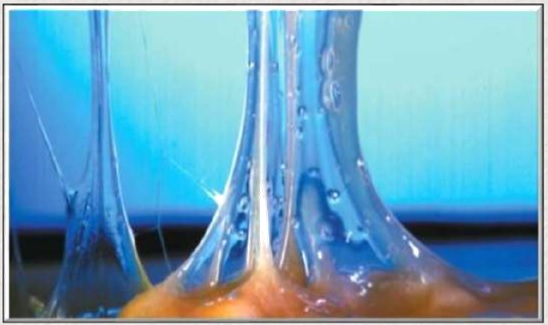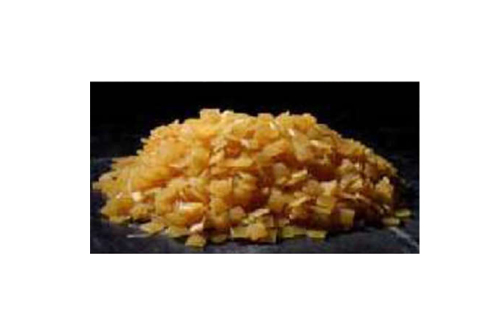THE EFFECT OF MINERAL OIL ON HOT MELT PRESSURE SENSITIVE ADHESIVES
Tom Tsaur, Consultant, Shanghai Frontier Adhesive Technology Co., Ltd, Shanghai, China Song Zhu, Research Manager, Shanghai Frontier Adhesive Technology Co., Ltd, Shanghai, China
Abstract
Most mineral oils (or plasticizers) used in hot melt pressure sensitive adhesives (HMPSAs) are composed of different ratios of paraffinic (%Cp), naphthenic (%Cn) and aromatic (%Ca) species. Though some mineral oils may have similar physical properties, such as color, molecular weight, flash point, pour point,etc., the carbon structure will greatly affect the glass transition temperature of both neat mineral oils and their formulated HMPSAs. Limited researches were done discussing the effect of mineral oil on HMPSAs. In this study, three different types of mineral oils, including a unique synthetically naphthenic oil containing 92% Cn, and three different types of Styrenic Block Copolymers (SBCs) were mixed to study the variation of basic physical properties- viscosity and softening point; pressure sensitive adhesion performances- tack, peel and holding power; and key rheological properties-Tg, Gno, G’ at 25°C, Tan delta min, and Flow Point.
Introduction
Most HMPSAs are composed of SBC, tackifiers and mineral oils. Each component plays an important role which will greatly affect the pressure sensitive adhesion performance. In a compatible adhesive blend, SBC offers cohesion, strength, and heat resistance; tackifier provides specific adhesion and reduces viscosity; and mineral oil greatly reduces viscosity, hardness and improves cold resistance.
In the HMPSA field, most researches were focused on the effect of the molecular structure of both SBC and tackifiers. Very limited studies were reported discussing the effect of mineral oils on HMPSAs. Most mineral oil suppliers simply supply basic oil properties without taking into account the compatibility of mineral oil with other ingredients, and the effect of varied mineral oils on PSA performance and rheology. Although most commercially available mineral oils are similar in color and odor, and they exhibit comparable basic oil physical properties, they greatly affect PSA rheology and performances when their carbon species are varied.
It is well accepted and recognized that the rheological properties of adhesive blends can be satisfactorily correlated with PSA performances, such as tack, peel, and holding power, etc. Dahlquist was the first researcher establishing the rheological criterion for PSAs1. To be an appreciable PSA, an adhesive should possess one second creep compliance greater than 1×10-6 cm2/dyne. S. G. Chu further defines that a general purpose PSA should impart a G’ at 25°C less than 2×106 dyne/cm2, and a Tg (Tan δ maximum) ranging from -10 to +10°C 2. Based on these simple guidelines, one can then easily tailor PSA performances based on rheological criteria without proceeding lots of trial-and-error experiments.
Experimental
1. Raw materials
In this study, three different mineral oils were selected to blend with various SBCs and tackifiers. They are a typical paraffinic oil (White oil #32, Shanghai Daliang Co.), a naphthenic oil (KN-4010, Karamay Petrochem Co.), and a unique synthetically naphthenic oil (Naphsol-200, Shanghai Dowpol Co.). SBCs and tackifiers used for this study are noted on the following tables.
2. Test Methods
Basic physical properties (viscosity and softening point) and PSA performances (180o peel, loop tack and holding power) tests were performed according to the PSTC and ASTM test methods. For rheological evaluations, all blended compounds were temperature scanned by a Rheometrics RDA-2 with an oscillatory frequency of 10 radians per second; a thickness of about 2.5mm on an 8 mm diameter parallel plates. Adhesive samples were all tested within their linear viscoelastic range.
Results and Discussion
1. Physical Properties and Rheological Properties of Neat Mineral Oils
Major physical properties and carbon species of used mineral oils are listed on Table 1. It is important to highlight that the carbon species of each mineral oil varies significantly. The %Cn of white oil #32, KN-4010, and Naphsol-200 are 30%, 51.7% and 92% respectively. The polarity and solubility parameter are related to %Cn (saturated cyclic carbon rings) in mineral oils. The higher the %Cn, the more polar the mineral oil is. Due to the polarity variation, each mineral oil demonstrates different compatibility with blended SBCs and tackifiers.
Table 1. Physical Properties of Tested Mineral Oils

*White Oil #32: Shanghai Daliang
*KN-4010: Karamay Naphthenic oil
*Naphsol 200: Dowpol Synthetically Naphthenic Oil
The rheological properties, G’ and Tan delta curves, of tested mineral oils are shown on Figure 1. It was found that the three neat mineral oils exhibited notably different transition temperatures (the inversion point at Tan delta curve). They were roughly -60°C, -35°C, and -25°C for White Oil #32, KN-4010, and Naphsol-200 respectively. Base on this fact, rheological properties of formulated HMPSAs will most likely be affected when different mineral oils are used in formulations.

2. Physical Properties, Adhesion Performances and Rheological Properties of SBC-based HMPSAs with Various Mineral Oils
Mineral oils containing varied %Cn may cause different degrees of compatibility with both mid-block (rubber phase) and end-block (styrene plastic phase) of SBCs. Three commercially available SBCs were selected for this study. They were Vector 4411 (ExxonMobil SIS, USA), GP-3545 (LCY SBS, Taiwan), and YH-501 (Yueyang SEBS, China). Each SBC was blended with a fixed tackifier and three different mineral oils using a reference weight ratio. Basic physical properties (viscosity and softening point), PSA performances (tack, peel, and hold), and rheological properties were evaluated. The correlation of PSA performances to the rheological properties are emphasized for three kinds of SBC-based formulations
A. SIS-based HMPSAs
Three SIS-based formulations containing various mineral oils are list on Table 2. Both viscosity and softening point were slightly different while PSA performances varied notably for three formulations. Both 180o peel and holding power boosted as the %Cn of mineral oil rose. Loop tack advanced to a certain level and then inversed as the %Cn of mineral oil increased. Once again, these PSA performance variations are closely related to the rheological property of each formulation.
Table 2. SIS-based HMPSAs – Formulation & Performances

*Vector 4411: ExxonMobil SIS
*C-100W: Yangzi Eastman Hydrogenated Hydrocarbon Resin
Rheological properties of three SIS-based HMPSAs are shown on Figure 2. It was observed that both Tg value (temperature at Tan delta maximum) and G’ curve at glass transition and plateau regions were higher for formulations containing mineral oil with more %Cn. For compatible polymer-diluents systems, the Tg of a blend can be predicted by the Flory-Fox equation. A mineral oil with higher Tg (i.e. containing more %Cn) will certainly result in a blend with a higher Tg. However, the higher polarity (i.e. more %Cn) mineral oil is less compatible with the isoprene rubber phase of SIS and therefore causes a high G’ curve at rubbery plateau region. This phenomenon can be explained by the deGennes’ equation.
Flory-Fox Equation
1/Tg’ = Σ(Wi/Tgi)
where Tg’ = Tg (oK) for polymer blends
Tgi = Tg (oK) for the individual component i
Wi = Weight fraction of component i
deGennes’ Equation
Gno = v2x Gnoo
where Gnoo is the Gno of the neat polymer
v2 is the volume fraction of polymer
x is an exponent which depends on the compatibility of the polymer diluents system

Key rheological properties of three SIS-based HMPSAs are listed on Table 3. Among these rheological properties, Tg is the determined parameter that will apparently affect PSA performances- peel, tack and holding power. The correlation of Tg and PSA performances are demonstrated on Figure 3.
For both peel and holding power measurements, test specimens were taped onto standard stainless steel test panels with a two pound rubber roller running back and forth once each direction. Peel and holding power are raised with the increase of Tg values. For peeling test, this result can be correlated with the value of Tan delta (damping factor) at the de-bonding stage3. A higher Tan delta value reflects a longer peeling leg or a greater elongation at the peeling front and will result in a higher peel force. For a holding power test, once the test specimen is successfully and intimately bonded on the test panel by the roller, the higher the G’ value upon shearing deformation, the stronger the cohesion is and the longer the holding time is. This correlation, however, may not be true when the adhesive’s Tg and G’ at 25°C are too high to successfully and intimately bond onto the test panel with a two pound roller.
No additional force other than the weight of test specimen was applied for a loop tack test. When a Tan delta value of a PSA is higher while G’ remaining at the rubbery plateau region below 2E6 dyne/cm2 at the bonding condition, the adhesive is able to wet the test panel better and generates a larger contact surface without additional pressure. Upon the observation on the peel separation after one second contact time, the higher Tan delta value associates to a longer peeling leg and a higher tack value. However, when the Tg of a PSA is too high while G’ at 25°C (or a specific test temperature) appears at the glass transition zone, since it is outside of Dalhquist criterion, the contact area is thus diminished as the Tg is raised. Loop tack value is therefore lowered dramatically after the Tg reaches a certain high value. In the SIS-based formulations, we found that an inverse of holding power for SIS-3. This is because the high Tg (23.5°C) accompanied with high G’ at 25°C (2.5E6 dyne/cm2) of SIS-3 makes it hard to wet onto the test panel intimately at short period of time and consequently results in a lower holding power.


B. SBS-based HMPSAs
Most commercially available SBS’ are inherently not easy to formulate into general purpose HMPSAs because of the lack of SB di-block. A SBS containing high amount of di-block was chosen for this study. Three SBS-based HMPSAs were prepared for the purpose of understanding the effect of mineral oils on SBS-based HMPSAs. Basic physical properties and PSA performances are listed on Table 4. Similar to those results observed in the SIS-based HMPSAs, the higher the %Cn of mineral oil was used in the formulations, the superior the peel, loop tack and holding power were with an exception of the tack performance of SBS-3. This outcome again can be easily explained and associated by their rheological properties.

*GP-3545: LCY (SBS, 63% di-block)
*SU-100: KOLON Hydrogenated Hydrocarbon Resin
Rheological properties of SBS-based HMPSAs are shown and listed on Figure 4 and Table 5 respectively. Similar to the finding for SIS-based HMPSAs, Tg and G’ at 25°C of those SBS-based HMPSA formulations were raised as the %Cn increased. Apparent rheological property difference for SBS and SIS-based HMPSA appeared at the rubbery plateau area. For SIS-based HMPSAs, Gno was raised when a more %Cn mineral oil was used. Contrarily, all three SBS-based HMPSAs exhibited similar Gno disregarding the mineral oils used. This phenomenon implies that all three mineral oils impart similar compatibilities with the butadiene rubber phase of SBS, according to the deGennes’ equation.
The correlations of SBS-based HMPSA performances to the rheological properties are presented on Figure 5. Both peel and holding power move up as the Tg of formulation raises. The inverse of loop tack for SBS-3 is resulted from high Tg (24.8°C) and high G’ at 25°C (2.3E6 dyne/cm2).

Figure 4. Rheological Properties of SBS-based HMPSAs


C. SEBS-based HMPSAs
Similar to SBS, most commercially available SEBS’ do not contain SEB diblock and are difficult to formulate into useful general purposed HMPSAs. Three SEBS-based formulations were prepared on purposely for studying the effect of mineral oil on HMPSAs. Table 6 lists the formulation, basic physical properties and PSA performances. Regardless the usefulness of these formulations in the real world applications, formulations containing different mineral oils apparently affects PSA performances. Similar to the trend observed for both SIS and SBS-based HMPSAs, all PSA performances improved as the %Cn in the formulation increased with an exception of SEBS-3 that presented a lower holding power than others.

* YH-501: Yueyang Petrochemical SEBS
Rheological properties of these formulations are shown on Figure 6 and Table 7. As expected, the Tg of formulated blends increased when a high %Cn mineral oil was used. Rubbery plateau moduli are essentially the same for three formulations containing various %Cn. This feature, as discussed above, implies that three mineral oils and ethylene-butylene rubber phase of SEBS have similar compatibilities.


Just like those correlations revealed for both SIS and SBS-based HMPSAs, the PSA performances correlated very well with the Tg of SEBS-based HMPSA formulations (Figure 7). Both peel and holding power improved significantly as the Tg increased. Loop tack basically followed the same correlation very well till the Tg (23.1°C) and G’ at 25°C (1.8E6 dyne/cm2) reached the limit of the PSA rheological criteria.
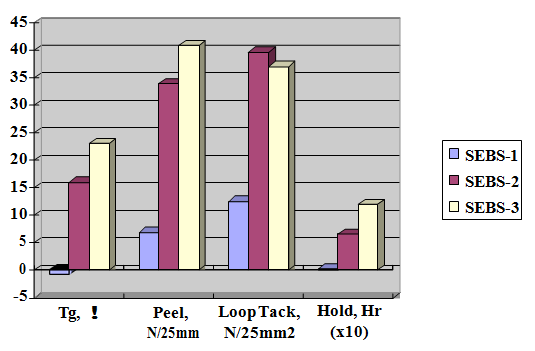
Figure 7. SEBS-based HMPSAs – Effect of Tg on Adhesion Performances
D. Correlation of HMPSA Performances and Rheological Parameters
Besides the well recognized PSA rheological criteria- Tg is ranging from -10 to +10°C and G’ at 25°C is lower than 2E6 dyne/cm2, some key rheological parameters, such as Gno, Tan delta minimum, and flow point (where Tan delta = 1), may also be correlated to certain PSA performances other than peel, tack and holding power. A sketched rheological diagram, G’ and Tan delta curves, for a HMPSA is shown on Figure 8. According to the Time-Temperature Superposition principle, rheological properties at low temperatures are essentially equivalent to their properties performed at shorter time and higher frequencies. Depending upon the test methods and conditions, rheological properties at varied zones can be correlated to the property of cold resistance, PSA performance, wetting, heat resistance, and processibility of HMPSAs. Since rheological properties and all HMPSA performances are closely related, any alteration of rheological properties caused by mineral oils will affect HMPSA performances as well.
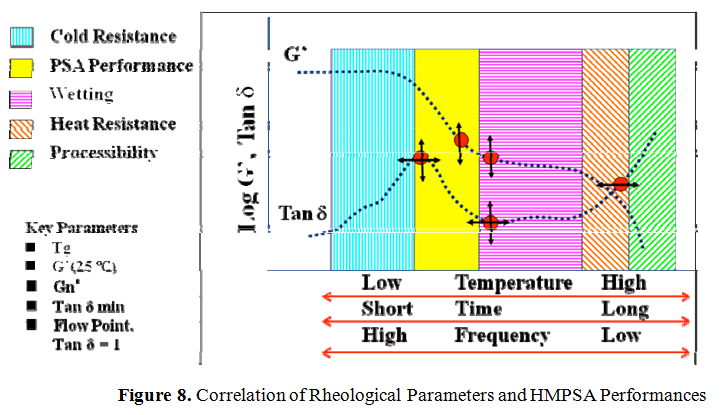
The effect of mineral oil on Tg of varied SBC-based HMPSAs is shown on Figure 9. Regardless of the type of SBC evaluated, mineral oils containing more %Cn always increased the Tg of the blended formulations. This feature will certainly affect room temperature PSA performances as discussed previously.

Besides Tg, other key rheological parameters were all affected by the varied mineral oils to a certain extent as shown on Figure 10. Consequently, some physical properties, adhesion performances, and processibility of HMPSAs will be also influenced by the alteration of certain rheological parameters. More studies are required to further define practical correlations between these rheological parameters and various adhesive properties.
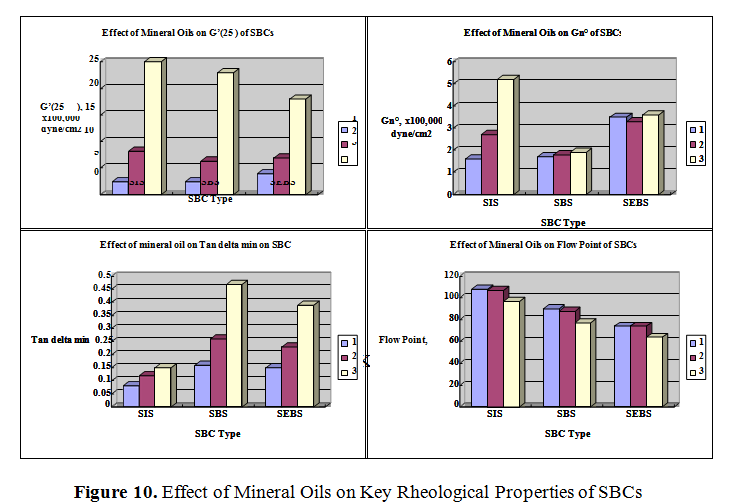
Conclusion
Three important findings are concluded from this study.
- Mineral oils are composed of various paraffinic (%Cp), Naphthenic (%Cn), and Aromatic (%Ca) species. The more %Cn is in mineral oil, the higher the Tg is of neat mineral oil and its formulated HMPSAs.
- HMPSA performances, such as peel, loop tack, and holding power, correlate very well with Tg and G’ at 25°C disregarding the type of
- The variation of PSA performance and rheological properties determined from different SBCs-oils blends is mainly a result of the compatibility difference between used SBCs, tackifiers and mineral oils.
Based on above findings, in addition to selecting appropriate SBCs and tackifiers, mineral oil also provides an alternative formulating route for developing desired HMPSA formulations.
References
1. Dahlquist, A. (1966), “Proceedings of Nottingham Conference on Adhesion. ‘Tack’ in Adhesion: Fundamentals and Practice.” Maclaren & Sons, Ltd, London.
2. Chu, G. (1989), “Viscoelastic Properties of Pressure Sensitive Adhesives” Satas, D, ed. 2nd. Edition 158-203. New York, Van Nostrand Reinhold Co. Inc.
3. Zhu, S., Tsaur, T., and Yang, F. (2008), “Study of Rheological Behavior of HMPSAs” in the World Adhesive Conference, Miami, Florida

TECH 32 Technical Seminar Speaker
The Effect of Mineral Oil on Hot Melt Pressure Sensitive Adhesives
Tom Tsaur, Consultant

Tom Tsaur is an independent technical consultant for hot melt adhesives. Prior to his consulting career, he founded two hot melt plants at Taiwan and Shanghai, China during 1994 and 2001 respectively. Before returning to Taiwan for his own business, he used to work with Arizona Chemical Company and NSC (Henkel) in the US. He actively participates in both US and Asian adhesive technical conferences. He made three consecutive presentations to TAPPI Hot Melt Symposium in 2002, 2003 and 2004; two presentations to 2004 WAC-Beijing, 2008 WAC-Miami, Florida USA and several speeches to Asia, Chinese and Taiwanese adhesive conferences. He also serves as an advisor for the China Adhesives Industry Association.
He can be reached at rheotsaur02@hotmail.com.

